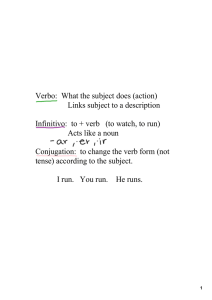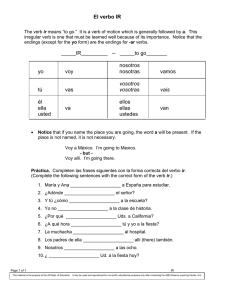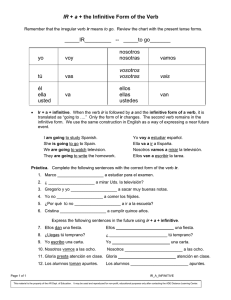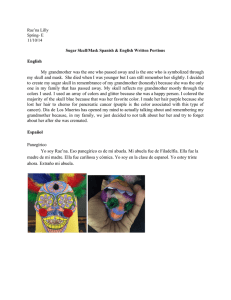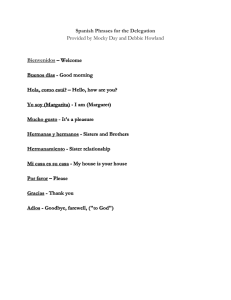AR present indicative
Anuncio
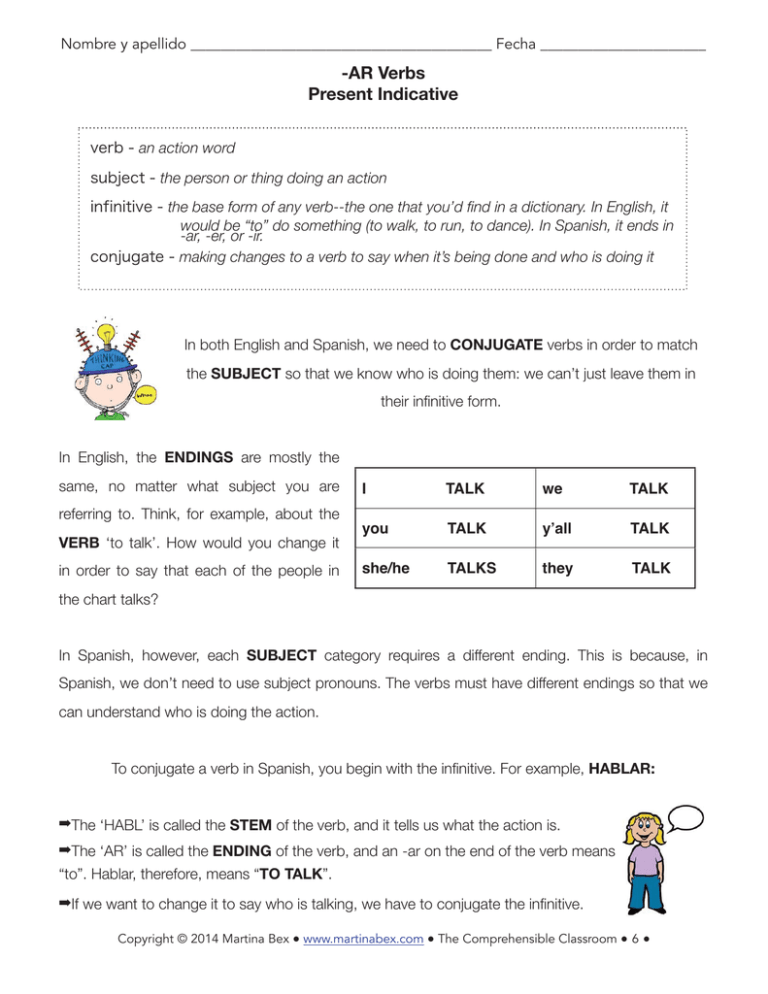
Nombre y apellido ________________________________________ Fecha ______________________ -AR Verbs Present Indicative verb - an action word subject - the person or thing doing an action infinitive - the base form of any verb--the one that you’d find in a dictionary. In English, it would be “to” do something (to walk, to run, to dance). In Spanish, it ends in -ar, -er, or -ir. conjugate - making changes to a verb to say when it’s being done and who is doing it In both English and Spanish, we need to CONJUGATE verbs in order to match the SUBJECT so that we know who is doing them: we can’t just leave them in their infinitive form. In English, the ENDINGS are mostly the same, no matter what subject you are referring to. Think, for example, about the VERB ‘to talk’. How would you change it in order to say that each of the people in I TALK we TALK you TALK y’all TALK she/he TALKS they TALK the chart talks? In Spanish, however, each SUBJECT category requires a different ending. This is because, in Spanish, we don’t need to use subject pronouns. The verbs must have different endings so that we can understand who is doing the action. To conjugate a verb in Spanish, you begin with the infinitive. For example, HABLAR: The ‘HABL’ is called the STEM of the verb, and it tells us what the action is. The ‘AR’ is called the ENDING of the verb, and an -ar on the end of the verb means “to”. Hablar, therefore, means “TO TALK”. If we want to change it to say who is talking, we have to conjugate the infinitive. Copyright © 2014 Martina Bex ● www.martinabex.com ● The Comprehensible Classroom ● 6 ● Nombre y apellido ________________________________________ Fecha ______________________ To conjugate a verb, we simply take off the old ending and add a new ending. For HABLAR, you’d first remove the -AR, then add a new ending that gives us information about WHO is talking. Here are the present indicative endings for yo (I) -O nosotros (we) -AMOS tú (you) -AS vosotros (y’all) -ÁIS ellos/ellas (they)/ Ustedes (you p.f.) -AN -AR verbs. Use them to say that someone DOES or IS DOING something. él (he)/ella (she)/ Usted (you formal) -A Let’s conjugate the verb “HABLAR”: First step: DROP YOUR ENDING __________________ (talk) Yo form/ Put an ‘o’ on it: __________________ (I talk/I am talking) Tú form/ Put ‘-as’ on it: __________________ (You talk/You are talking) Él/ella form/ Put an ‘a’ on it: __________________ (He talks/He is talking) Nosotros form/ Put an ‘amos’ on it: __________________ (We talk/We are talking) Vosotros form/ Put an ‘áis’ on it: __________________ (Y’all talk/Y’all are talking) Ustedes form/ Put ‘-an’ on it: __________________ (You all talk/are talking) (They talk/They are talking) Try these! First, underline the verb. Then, circle the subject. Finally, translate the sentence on the line. I am yelling at my brother (gritar): _______________________________________________ You dance like Michael Jackson (bailar): _______________________________________________ My mom works at McDonalds (trabajar): _______________________________________________ We walk to school (caminar): _______________________________________ Y’all are looking for a TV (buscar): ________________________________________ Linda and Katie sing well (cantar): ____________________________________ Copyright © 2014 Martina Bex ● www.martinabex.com ● The Comprehensible Classroom ● 7 ● Nombre y apellido ________________________________________ Fecha ______________________ To conjugate a verb, we simply take off the old ending and add a new ending. For HABLAR, you’d first remove the -AR, then add a new ending that gives us information about WHO is talking. Here are the present indicative endings for yo (I) -O nosotros (we) -AMOS tú (you) -AS vosotros (y’all) -ÁIS ellos/ellas (they)/ Ustedes (you p.f.) -AN -AR verbs. Use them to say that someone DOES or IS DOING something. él (he)/ella (she)/ Usted (you formal) -A Let’s conjugate the verb “HABLAR”: First step: DROP YOUR ENDING HABL- (talk) Yo form/ Put an ‘o’ on it: HABLO (I talk/I am talking) Tú form/ Put ‘-as’ on it: HABLAS (You talk/You are talking) Él/ella form/ Put an ‘a’ on it: HABLA (He talks/He is talking) Nosotros form/ Put an ‘amos’ on it: HABLAMOS Vosotros form/ Put an ‘áis’ on it: HABLÁIS (Y’all talk/Y’all are talking) Ustedes form/ Put ‘-an’ on it: HABLAN (You all talk/are talking) (They talk/They are talking) (We talk/We are talking) Try these! First, underline the verb. Then, circle the subject. Finally, translate the sentence on the line. I am yelling at my brother (gritar): YO LE GRITO A MI HERMANO. You dance like Michael Jackson (bailar): TÚ BAILAS COMO MICHAEL JACKSON My mom works at McDonalds (trabajar): MI MAMÁ TRABAJA EN MCDONALDS We walk to school (caminar): NOSOTROS CAMINAMOS A LA ESCUELA Y’all are looking for a TV (buscar): VOSOTROS BUSCÁIS UN TELEVISOR Linda and Katie sing well (cantar): ELLAS CANTAN BIEN Copyright © 2014 Martina Bex ● www.martinabex.com ● The Comprehensible Classroom ● 8 ● Nombre y apellido ________________________________________ Fecha ______________________ La vida linda de Linda As you read the following story about Linda, conjugate the missing verbs (they are in the parentheses) according to the subject given. La mamá de Linda TRABAJA (trabajar) en McDonalds todos los días. Por eso, Linda CAMINA (caminar) a la casa de su abuela para pasar tiempo con ella. En la casa de su abuela, Linda MIRA (mirar) videos en YouTube. Si ella MIRA (mirar) muchos videos, su abuela le GRITA (gritar). Entonces, Linda ESTUDIA (estudiar) las matemáticas o las ciencias o PRACTICA (practicar) el piano. A veces, la abuela de Linda CANTA (cantar) mientras Linda lo PRACTICA (practicar). ¡Su abuela CANTA (cantar) muy bien! Después de trabajar, la mamá de Linda LLAMA (llamar) a Linda por teléfono y le dice, «Estoy aquí», y Linda CAMINA (caminar) a su casa. Now, please re-write the story from the first-person perspective; as if YOU were Linda and were talking about yourself. You will need to change some verbs to the “yo” form, as well as changing other words so that the story makes sense (her - my, she - I, etc.) Mi mamá trabaja en McDonalds todos los días. Por eso, yo camino a la casa de mi abuela para pasar tiempo con ella. En la casa de mi abuela, yo miro la televisión. Si yo miro mucha televisión, mi abuela me grita. Entonces, yo estudio las matemáticas o las ciencias o practico el piano. A veces, mi abuela canta mientras yo lo practico. ¡Mi abuela canta muy bien! Después de trabajar, mi mamá me llama por teléfono y me dice, «Estoy aquí» y yo camino a mi casa. Now, imagine that Linda has a twin brother named Chao, and they do everything together. Write the story from Chao’s perspective, keeping in mind that he does everything that Linda does! Nuestra mamá trabaja en McDonalds todos los días. Por eso, nosotros caminamos a la casa de nuestra abuela para pasar tiempo con ella. En la casa de nuestra abuela, nosotros miramos la televisión. Si nosotros miramos mucha televisión, nuestra abuela nos grita. Entonces, nosotros estudiamos las matemáticas o las ciencias o practicamos el piano. A veces, nuestra abuela canta mientras nosotros lo practicamos. ¡Nuestra abuela canta muy bien! Después de trabajar, nuestra mamá nos llama por teléfono y nos dice, «Estoy aquí» y nosotros caminamos a nuestra casa. Copyright © 2014 Martina Bex ● www.martinabex.com ● The Comprehensible Classroom ● 9 ●
